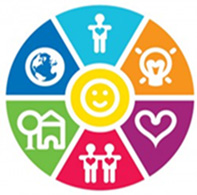Primary
The six ways to wellbeing are simple evidence-based ways to improve our mood, reduce our risk of depression, strengthen relationships and keep us healthy. Here are lesson plans and power points designed for use by professionals for pupils KS1-5 and for staff wellbeing.
 The wheel of well-being is made up of six easy steps, so why not give them a try and see how they can make a difference to your happiness?
The wheel of well-being is made up of six easy steps, so why not give them a try and see how they can make a difference to your happiness?
The wheel of wellbeing can also be used in your everyday work life to help improve your mood and reduce stress.
Be active… Go for a walk or run. Step outside. Cycle. Play a game. Garden. Dance. Exercising makes you feel good. Most importantly, discover a physical activity you enjoy; one that suits your level of mobility and fitness.
Keep learning…Try something new. Rediscover an old interest. Sign up for that course. Take on a different responsibility at work. Fix a bike. Learn to play an instrument or how to cook your favourite food. Set a challenge you will enjoy achieving. Learning new things will make you more confident, as well as being fun to do.
Give… Do something nice for a friend, or a stranger. Thank someone. Smile. Volunteer your time. Join a community group. Look out, as well as in. Seeing yourself, and your happiness, linked to the wider community can be incredibly rewarding and will create connections with the people around you.
Connect…With the people around you. With family, friends, colleagues and neighbours. At home, work, school or in your local community. Think of these as the cornerstones of your life and invest time in developing them. Building these connections with support and enrich you every day.
Take notice… Be curious. Catch sight of the beautiful. Remark on the unusual. Notice the changing seasons. Savour the moment, whether you are on a train, eating lunch or talking to friends. Be aware of the world around you and what you are feeling. Reflecting on your experiences will help you appreciate what matters to you.
Care for the planet... look after your community and the world. Make small changes to your life that will reduce your energy use, recycle more, leave the car at home, use low energy light bulbs, small steps to a greener life can make a difference.
- Lesson plan for (35-45mins) Six ways to wellbeing workshop for KS1
- Lesson plan for (one hour) workshop for Six ways to wellbeing for KS2
- Six ways to wellbeing primary powerpoint presentation
- Six ways to wellbeing staff session powerpoint presentation
Secondary
- Lesson plan for Six ways to wellbeing and managing stress workshop for KS3
- Six ways to wellbeing secondary powerpoint presentation
Accessing support for young people
Here you will find presentations created for young people, explaining how to access online support offers and what will happen if they wish to seek support online.
Chat Health
A short presentation for young people on how they can access and use the ChatHealth Service. Young people can text the team about anything:
- exam stress
- if they are feeling sad or have low mood
- sexual health or body image concerns
- healthy lifestyle advice
- or if they feel anxious or worried about anything.
Kooth
Kooth offers emotional and mental health support for children and young people aged between 11 and 24. They have a suite of resources for pupils and staff to discover everything Kooth has to offer resource pack for teachers/schools and video pack for schools
Online courses for young people
This online course is suitable for PHSE lessons for secondary age children aged 13 and older. Help the teenagers in your school to understand what is happening as their brain continues to develop:
‘Understanding your brain, for teenagers only!’
- Have you noticed changes in your behaviour?
- Do you sleep more than you used to?
- Want to know why teenagers are more open-minded?
Register at: inourplace.co.uk and enter the access code ‘INVICTA’ for free access.
The hand model of the brain is a short video explaining Dr. Daniel Siegel’s hand model of the brain and a great one to share with your children and young people.
The hand model allows us to picture our brain structure and understand why it’s difficult to control our reactions when we’re overwhelmed with strong emotions, especially stress.